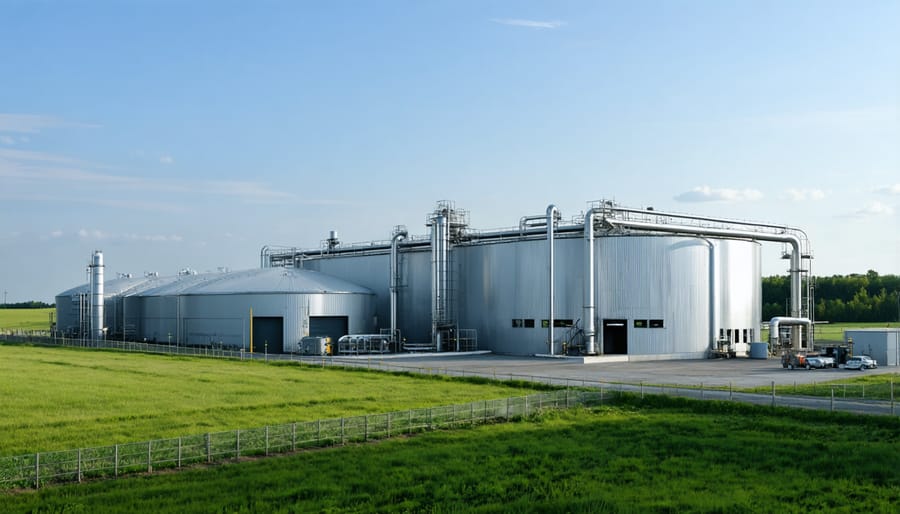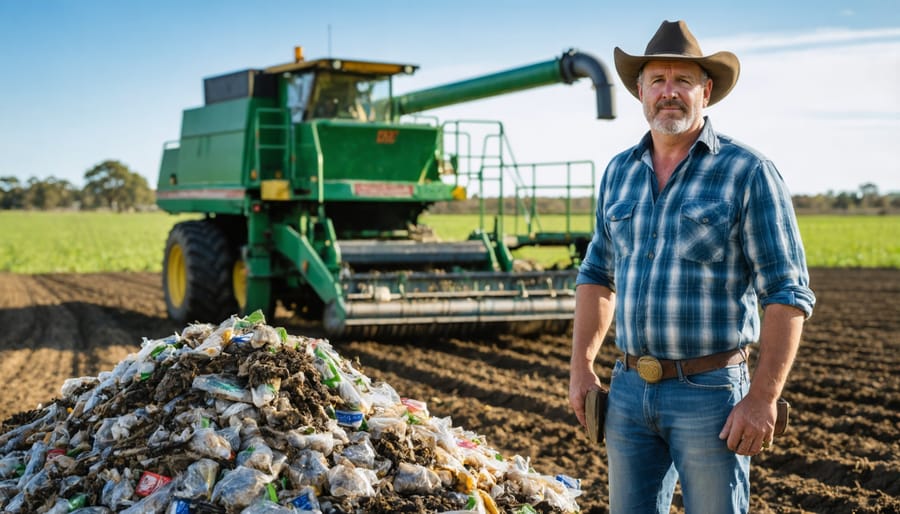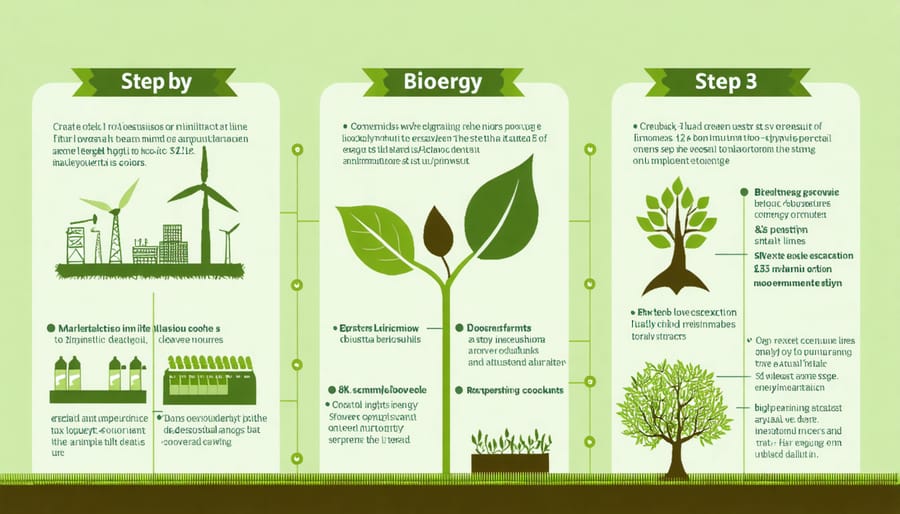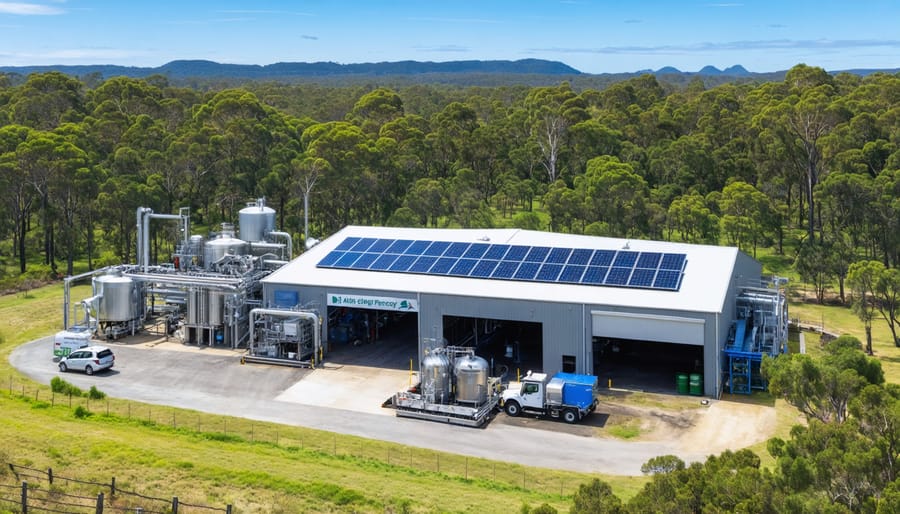Transform your business into a sustainable powerhouse by harnessing Australia’s renewable energy revolution. Forward-thinking companies are already thriving with bioenergy solutions, cutting operational costs by up to 40% while building stronger community relationships and securing government incentives.
The sustainable energy sector in Australia has reached a critical turning point. With renewable energy costs plummeting by 82% since 2010 and state governments offering unprecedented support for green initiatives, businesses that embrace sustainable practices now position themselves at the forefront of an industry projected to generate $370 billion by 2025.
This isn’t just about environmental responsibility – it’s about seizing a competitive advantage. Australian businesses implementing sustainable energy solutions report enhanced brand value, increased customer loyalty, and improved operational efficiency. From solar-powered manufacturing facilities to waste-to-energy systems in agriculture, innovative companies are proving that sustainability drives profitability while ensuring long-term resilience in an increasingly resource-conscious market.
Discover how your business can join Australia’s sustainable energy revolution, reduce operational costs, and build a future-proof enterprise that delivers both environmental and economic benefits.
Why Bioenergy Makes Business Sense for Australian SMEs
Cost-Effective Energy Solutions
For small businesses in Australia, implementing sustainable energy solutions isn’t just about environmental responsibility – it’s a smart financial decision. Research shows that businesses adopting cost-effective energy storage solutions typically see a return on investment within 3-5 years, with energy cost reductions of up to 40%.
Local cafes and small manufacturers have reported significant savings after installing solar panels combined with battery storage systems. For instance, a Melbourne-based bakery reduced its monthly energy bills by $1,200 after switching to renewable energy, while also attracting environmentally conscious customers.
The initial investment can be offset through various government incentives and rebates available to Australian businesses. Small-scale technology certificates (STCs) and feed-in tariffs provide additional revenue streams, making the transition more financially viable. Many businesses are also finding success with power purchase agreements (PPAs), which allow them to access renewable energy without large upfront costs.
Energy-efficient lighting, smart meters, and automated energy management systems further complement these solutions, creating comprehensive cost savings while supporting sustainability goals.

Government Incentives and Support
The Australian government offers substantial support for businesses transitioning to sustainable energy solutions. The Renewable Energy Target (RET) scheme provides financial incentives through Large-scale Generation Certificates (LGCs) and Small-scale Technology Certificates (STCs), making renewable energy investments more attractive for businesses of all sizes.
Small and medium enterprises can access grants through the Clean Energy Finance Corporation (CEFC), which offers competitive financing options for sustainable energy projects. The Environmental Upgrade Finance program enables building owners to secure better loan terms for energy efficiency improvements, with repayments collected through local council rates.
Tax benefits include instant asset write-offs for renewable energy equipment and accelerated depreciation for eligible sustainable energy installations. The Australian Renewable Energy Agency (ARENA) provides matching funding for innovative renewable energy projects, particularly favouring regional initiatives and emerging technologies.
State-level incentives vary, with Victoria’s Energy Saver Incentive and New South Wales’s Energy Savings Scheme offering additional support. Local councils often provide supplementary grants and planning assistance for businesses implementing sustainable energy solutions, creating a multi-layered support system for green initiatives.
Success Stories: Australian Businesses Leading the Way
Farm-to-Energy Innovation
Australian farmers are leading the charge in sustainable energy innovation, transforming rural businesses through clever waste-to-energy solutions. The Darling Downs region showcases this brilliantly with the Thompson family farm, which converted their annual 20,000 tonnes of agricultural waste into a thriving bioenergy operation.
Using advanced anaerobic digestion technology, they now process crop residues and livestock manure to generate enough electricity to power their entire farming operation and sell surplus energy back to the grid. This innovative approach has slashed their energy costs by 75% while creating an additional revenue stream.
Similar success stories are emerging across Victoria and New South Wales, where dairy farms are turning methane from cow manure into biogas. The Mitchell family dairy farm in Gippsland installed a biodigester system that not only powers their milking facility but also produces high-quality fertilizer as a by-product.
These waste-to-energy initiatives are proving that sustainable farming isn’t just good for the environment – it’s good business sense. Farmers report significant reductions in waste management costs, lower energy bills, and new income opportunities. The model is particularly effective for medium to large-scale agricultural operations looking to reduce their carbon footprint while improving their bottom line.
With government incentives supporting agricultural businesses in their transition to renewable energy, more farmers are exploring these innovative solutions, creating a ripple effect throughout rural communities.

Urban Business Solutions
In the heart of Melbourne’s bustling CBD, the Metropolitan Hotel has revolutionized its energy systems by implementing an innovative bioenergy solution that converts food waste into power. This smart initiative not only reduces their waste management costs by 40% but also generates enough energy to power their kitchen operations and heating systems.
Sydney’s Riverside Commercial Complex demonstrates another successful urban bioenergy implementation. Their building-wide organic waste collection system feeds into an on-site biodigester, producing biogas that powers their backup generators and supplements their heating requirements. This system has helped reduce their carbon footprint by 30% while saving approximately $50,000 annually in energy costs.
The Green Square Shopping Centre in Brisbane showcases how retail spaces can embrace bioenergy solutions. Their partnership with local cafes and restaurants created a waste-to-energy ecosystem that processes over 3,000 tonnes of organic waste annually. The generated biogas powers the centre’s air conditioning systems and provides hot water for their food court tenants.
These urban success stories highlight how Australian businesses are turning waste management challenges into energy opportunities. By implementing bioenergy systems, these enterprises have not only reduced their environmental impact but have also created new revenue streams and significant cost savings, proving that sustainable energy solutions can thrive in urban environments.

Getting Started with Bioenergy
Assessment and Planning
Conducting a thorough assessment of your business’s energy needs is the crucial first step in transitioning to sustainable energy solutions. Start by performing an energy audit to understand your current consumption patterns, peak usage times, and major energy-demanding processes. This baseline data will help identify areas where sustainable alternatives can make the most impact.
Consider engaging certified energy consultants who can provide detailed analysis and recommendations tailored to your business. They’ll evaluate factors like your location, available space, operational hours, and seasonal variations in energy demand. This expertise proves invaluable in determining the most suitable mix of renewable energy solutions.
When planning your sustainable energy transition, adopt a staged approach. Begin with energy efficiency measures – these often provide quick wins with minimal investment. Next, assess your potential for on-site renewable energy generation, particularly solar given Australia’s abundant sunshine. Don’t overlook opportunities for waste-to-energy solutions if your business generates organic waste.
Financial planning is equally important. Research available government incentives, grants, and renewable energy certificates that can offset initial costs. Create a detailed budget that accounts for installation, maintenance, and projected energy savings. Many businesses find that while upfront costs may be significant, the long-term savings and environmental benefits make the investment worthwhile.
Remember to involve key stakeholders early in the planning process. Staff engagement and training will be crucial for successful implementation, while clear communication with suppliers and customers can enhance your business’s green credentials.
Implementation and Management
Implementing a sustainable energy system requires careful planning and systematic execution. Start by conducting a thorough energy audit to identify your current consumption patterns and potential areas for improvement. This baseline assessment will help determine the most suitable bioenergy solutions for your needs.
Next, develop a detailed implementation timeline that includes key milestones and resource allocation. Consider factors such as equipment installation, staff training, and regulatory compliance. Many Australian businesses find success by starting with smaller pilot projects before scaling up their bioenergy initiatives.
Regular maintenance is crucial for optimal system performance. Establish a comprehensive maintenance schedule that includes daily monitoring, weekly inspections, and quarterly professional assessments. Train your staff to recognize early warning signs of system issues and implement preventive measures.
Data collection and analysis play vital roles in system management. Use smart meters and monitoring systems to track energy production, consumption, and efficiency metrics. This information helps identify optimization opportunities and demonstrate ROI to stakeholders.
Partner with local experts and service providers who understand the Australian context and can provide ongoing support. Many successful implementations involve collaboration with renewable energy specialists, equipment manufacturers, and maintenance professionals.
Remember to regularly review and update your management strategies as technology evolves and new opportunities emerge. Stay connected with industry networks and sustainable energy groups to share experiences and learn from others’ successes.
Future Growth Opportunities
Market Expansion
The sustainable energy sector in Australia is experiencing unprecedented growth, driven by increasing environmental awareness and favorable government policies. As communities and businesses prioritize clean energy solutions, growing investment opportunities are emerging across the continent.
Regional markets, particularly in agricultural areas, are showing strong potential for bioenergy adoption. Farmers and agricultural businesses are increasingly recognizing the dual benefits of waste management and energy production, creating a robust market for sustainable energy solutions. Small towns and remote communities are also emerging as key markets, seeking energy independence and reduced operational costs.
The commercial and industrial sectors present significant expansion opportunities, with many businesses looking to reduce their carbon footprint while maintaining operational efficiency. Hotels, manufacturing facilities, and food processing plants are leading the charge in adopting sustainable energy systems, setting new industry standards and creating ripple effects throughout their supply chains.
Export markets, particularly in the Asia-Pacific region, are showing keen interest in Australian sustainable energy expertise and technology. This international demand is creating new pathways for local businesses to scale their operations and share their innovations globally.
The rise of sustainable building practices and green certifications has opened additional market segments, with property developers and building managers actively seeking renewable energy solutions. This trend is particularly strong in urban centers where environmental credentials increasingly influence property values and tenant decisions.
With the convergence of environmental consciousness, technological advancement, and economic viability, the sustainable energy market is poised for continued expansion, offering promising opportunities for businesses ready to meet this growing demand.
Innovation and Technology
The renewable energy sector is witnessing unprecedented technological breakthroughs that are reshaping the business landscape. Smart grid technologies, enhanced by artificial intelligence and machine learning, are enabling businesses to optimise their energy consumption and reduce operational costs. These innovations are particularly game-changing for Australian businesses, where the abundant solar resources can now be harnessed more efficiently than ever before.
Battery storage technology is experiencing rapid advancement, with new solutions offering longer life spans and improved storage capacity at increasingly competitive prices. This development is crucial for businesses looking to maintain consistent energy supply while reducing their carbon footprint. Companies like South Australian Tesla’s big battery have demonstrated how large-scale storage can provide both grid stability and profitable business opportunities.
Emerging hydrogen technologies are opening new frontiers for sustainable energy businesses. Green hydrogen production, powered by renewable energy, is becoming increasingly viable as electrolysis technology improves and costs decrease. Several Australian companies are already positioning themselves at the forefront of this revolution, developing hydrogen hubs and export facilities.
Blockchain technology is revolutionising energy trading, enabling peer-to-peer energy markets where businesses can buy and sell excess renewable energy directly. This democratisation of energy trading is creating new revenue streams for businesses while promoting greater energy independence.
The integration of Internet of Things (IoT) devices in energy management systems is helping businesses monitor and optimise their energy usage in real-time. These smart systems can automatically adjust energy consumption based on demand, weather conditions, and energy prices, leading to significant cost savings and improved efficiency.
Looking ahead, the convergence of these technologies promises to create even more innovative business models and opportunities in the sustainable energy sector. Australian businesses that embrace these technological advancements will be well-positioned to lead in the clean energy future.
As we’ve explored throughout this article, bioenergy presents an incredible opportunity for Australian businesses to lead the charge in sustainable energy transformation. The success stories we’ve shared, from regional agricultural operations to urban manufacturing facilities, demonstrate that embracing bioenergy isn’t just environmentally responsible – it’s commercially smart.
The time to act is now. With government incentives, advancing technologies, and growing consumer demand for sustainable practices, businesses have all the tools they need to make the switch. The benefits are clear: reduced operational costs, enhanced brand reputation, and a smaller carbon footprint that positions companies for long-term success in an increasingly environmentally conscious market.
For businesses considering this transition, start by assessing your current energy needs and available biomass resources. Connect with industry experts and local sustainability networks to understand the best implementation strategy for your specific situation. Remember, every journey toward sustainability starts with a single step, and there’s no better time than the present to begin.
By embracing bioenergy, your business can join the growing community of forward-thinking Australian enterprises that are helping to shape a cleaner, more sustainable future. The path to renewable energy might seem challenging, but the rewards – both for your bottom line and our planet – make it a journey worth taking.
Let’s make sustainable energy the cornerstone of Australian business success. Your next business decision could be the one that helps transform our energy landscape for generations to come.

